|
In our introduction to Positional play (see the link box at the end of this article), we list a half dozen elements that distinguish a strong position from a weak one.
One of those elements is the Pawn structure : the position of the Pawns, ignoring the position of all other pieces.
In our introduction to Planning (see the link box again) we say, 'The plan arises from the position on the board. The Pawn structure is one of the most important elements of the position.'
What makes the Pawn structure so important?
Unlike the other pieces, which can make as many moves as required in a single game, each Pawn is limited to a maximum of five or six moves.
The Pawns advance slowly and deliberately.
The consequence is that the Pawn structure itself evolves slowly and a single aspect of that structure can remain fixed for many moves, sometimes for the remainder of the game.
In this article we're going to look at some of the basic types of Pawn structure.
These are so fundamental that they have been given names by generations of chess players and writers.
Since both players manipulate a separate formation of Pawns, many common configurations come from how the two Pawn structures relate to each other.
A Pawn is passed because there are no opposing Pawns; another Pawn is backward because it has no opposing Pawn on the same file.
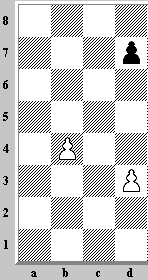 |
Passed Pawn
Our first example is a key factor in the endgame.
In our series on elementary endgames (link box again) we say, 'An extra Pawn is an advantage; when it's an outside passed Pawn, it's a big advantage.'
A passed Pawn is a Pawn which has no opposing Pawn in front of it or on a file to the side.
The b-Pawn in our diagram is an example of a passed Pawn.
The two d-Pawns are not passed, because they stand in the way of each other.
The advantage of a passed Pawn is that it constantly threatens to advance to its eighth rank where it will promote to a more powerful piece, usually a Queen.
It requires constant attention by the enemy pieces.
|
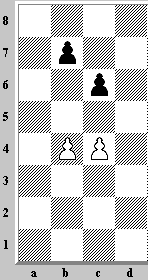 |
Connected Pawns
The most favorable position of two Pawns is side by side.
In the diagram, the b- and c-Pawns for both sides are connected (sometimes called united).
Each Pawn, wherever it is placed on the chessboard, has certain squares which are more important to that Pawn than other squares.
These are
- the two squares diagonally in front where it can capture an enemy piece or guard a friendly piece (one square diagonally for a Pawn on the a- or h-file), and
- the square directly in front where it is blocked by any piece occupying the square.
These are called the Pawn's strong squares and weak square.
The strongest formation of connected Pawns is illustrated by the White Pawns in the diagram, where each Pawn controls the weak square of the Pawn to its side.
The Black Pawns, which are also connected, are not as strong because neither controls the other's weak square.
Their position is not entirely weak, because the b-Pawn guards the c-Pawn.
Pawns on adjacent files separated by more than one rank, are not connected : this would be the case in our diagram if the White b-Pawn were still on b2.
They become connected if the lagging Pawn advances.
|
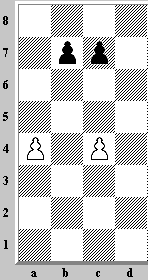 |
Isolated Pawns
In sharp contrast to the strength of connected Pawns is the weakness of isolated Pawns.
These are Pawns which have no friendly Pawn on either adjacent file.
Both White's a-Pawn and c-Pawn in the diagram are isolated.
They are weak because any enemy piece can occupy the square in front without fear of being attacked by another Pawn.
In the diagram, any Black piece on c5 would attack squares in White's camp.
The c-Pawn would also protect it from attack by a Rook on the c-file.
|
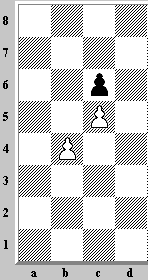 |
Backward Pawn
Another example of a weak Pawn is shown in this diagram.
The b-Pawn is backward because it lags the Pawn to its side and can no longer be protected by any other Pawn.
Pawns are only called backward when they are on a half-open file : a file with no opposing enemy Pawn.
If a Black Pawn were on b7, the White b-Pawn would not be backward.
The backward Pawn is weak because it is easily blocked by an enemy piece and has difficulty advancing, especially where its weak square is controlled by an enemy Pawn, as in the diagram.
Backward Pawns are obvious targets for the enemy pieces.
|
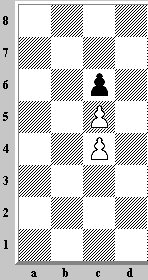 |
Doubled Pawns
Pawns of the same color on the same file, like the White c-Pawns in the diagram, are called doubled Pawns.
Their particular weakness is that they are unable to create a passed Pawn by force.
The single Black Pawn easily blocks its two adversaries.
Doubled Pawns have some strength in that they guard a compact area of the chess board, making it difficult for an enemy piece to enter that area.
The squares b5, b6, d5, and d6 are all protected by the doubled c-Pawns in the diagram.
If another White Pawn were on c2 or c3, we would have an example of tripled Pawns.
This is a particularly weak formation because all three Pawns can be blocked by a single enemy piece, while the Pawns can't protect each other and are vulnerable to attack.
|
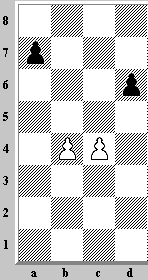 |
Hanging Pawns
Another common example of a Pawn formation having both strength and weakness is shown in this diagram.
As we saw earlier, the connected b- and c-Pawns are strong, but here they sit on half-open files.
This makes them vulnerable to attack from the enemy pieces, especially the Rooks.
If either Pawn advances, the other Pawn becomes backward, transforming the strong connected Pawns into weak connected Pawns.
|
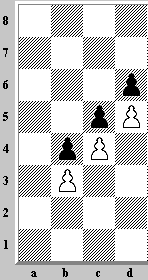 |
Pawn chain
Connected Pawns on a diagonal are known as a chain.
Although two Pawns on a diagonal can be considered a chain, the term is usually applied to three or more Pawns.
If we remove two or three of the Black Pawns (or even the single Pawn on c5) from the diagram, the remaining White Pawns would still make a chain.
The Pawns on d5 and b4 are the head of their respective chains; the Pawns on b3 and d6 are the base.
The diagram shows both White and Black Pawns in a chain where each chain blocks the other, effectively dividing the board into one region behind the White Pawns and another behind the Black Pawns.
The blocked chain makes it difficult for the other pieces to move quickly from one of these regions to another.
|
 |
Pawn majority
As we already saw in the first diagram, a passed Pawn can be a real advantage.
Where a player has more Pawns than the opponent on one side of the board, that player can advance the Pawns to create a passed Pawn.
This formation is called a majority.
The diagram shows a Queenside majority.
The same formation mirrored on the other side of the board would be a Kingside majority.
Sometimes a player has more Pawns on one side, but is unable to create a passed Pawn by force.
This would be the case in the diagram if we moved the c-Pawn from c4 to b3.
This is called a crippled majority and is always associated with doubled Pawns.
|
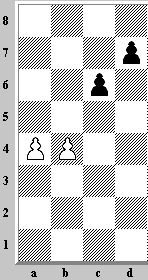 |
Connected Pawns, one passed
The basic Pawn formations can be combined in different ways to create more complex formations.
Here White has connected Pawns where the a-Pawn is a passed Pawn.
The Black d-Pawn might also be passed; it depends whether White has a Pawn on the e-file or not.
If we remove the Black c-Pawn, the White Pawns would become connected passed Pawns.
This is a very strong formation and a tangible advantage in an endgame.
|
 |
Passed, doubled Pawns
If you've followed the discussion to this point, you recognize that White's c-Pawns are doubled and passed.
While nowhere near as strong as connected passed Pawns, White's formation can be an advantage in the endgame.
The Pawns provide natural protection for White's pieces to occupy the central squares d5 and d6.
The lead c-Pawn can eventually be exchanged, leaving another passed Pawn in its wake.
|
***
If Pawns had a motto, it would be 'United we stand; divided we fall.'
Connected Pawns are strong while isolated Pawns are weak.
Consider the following diagram.
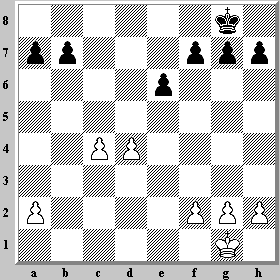 Pawn islands
Pawn islands
White has an isolated Pawn at a2, hanging Pawns at c4 & d4, and three connected Pawns at f2, g2, & h2.
Black has one set of connected Pawns at a7 & b7 and another stretching from e6 to h7.
If we count the sets of connected Pawns for each side, we have three for White and two for Black.
In other words, White has three Pawn islands, while Black has two.
All other things being equal, the player with fewer Pawn islands has an advantage, because the individual Pawns are easier to defend against enemy attacks.
The Pawns in each island defend each other and cover the others' weak squares.
Each player starts with eight connected Pawns stretching from the a-file to the h-file.
As the Pawns advance and are exchanged, the islands appear.
Advanced Pawns
The last topic in our introduction to Pawn structure is another example of how Pawns can create strengths and weaknesses at the same time.
Advanced Pawns are those Pawns that have moved past their own fourth rank into the opponent's side of the board.
As they advance into enemy territory they
- cramp the opponent and restrict the activity of the enemy pieces, but
- are subject to encirclement and capture.
Their advance also
- gives their own pieces more freedom of movement, but
- leaves unprotected areas in their own camp which can be invaded by enemy pieces.
As is so often true in chess, each position has to be judged objectively and on its own merits.
Where one player sees an opportunity, another sees a disadvantage.
A particular Pawn structure can be either weak or strong depending on which other pieces remain on the board.
We'll say more about this in a companion article.
|


